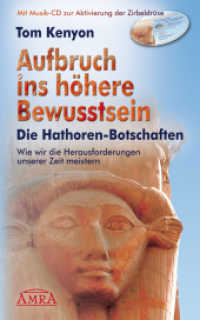Full Description
This volume presents a sketch of the Meaning-Text linguistic approach, richly illustrated by examples borrowed mainly, but not exclusively, from English. Chapter 1 expounds the basic idea that underlies this approach—that a natural language must be described as a correspondence between linguistic meanings and linguistic texts—and explains the organization of the book. Chapter 2 introduces the notion of linguistic functional model, the three postulates of the Meaning-Text approach (a language is a particular meaning-text correspondence, a language must be described by a functional model and linguistic utterances must be treated at the level of the sentence and that of the word) and the perspective "from meaning to text" for linguistic descriptions. Chapter 3 contains a characterization of a particular Meaning-Text model: formal linguistic representations on the semantic, the syntactic and the morphological levels and the modules of a linguistic model that link these representations.
Chapter 4 covers two central problems of the Meaning-Text approach: semantic decomposition and restricted lexical cooccurrence (? lexical functions); particular attention is paid to the correlation between semantic components in the definition of a lexical unit and the values of its lexical functions. Chapter 5 discusses five select issues: 1) the orientation of a linguistic description must be from meaning to text (using as data Spanish semivowels and Russian binominative constructions); 2) a system of notions and terms for linguistics (linguistic sign and the operation of linguistic union; notion of word; case, voice, and ergative construction); 3) formal description of meaning (strict semantic decomposition, standardization of semantemes, the adequacy of decomposition, the maximal block principle); 4) the Explanatory Combinatorial Dictionary (with a sample of complete lexical entries for Russian vocables); 5) dependencies in language, in particular—syntactic dependencies (the criteria for establishing a set of surface-syntactic relations for a language are formulated).
Three appendices follow: a phonetic table, an inventory of surface-syntactic relations for English and an overview of all possible combinations of the three types of dependency (semantic, syntactic, and morphological). The book is supplied with a detailed index of notions and terms, which includes a linguistic glossary.
Contents
Contents Acknowledgments
The Author's Foreword
Chapter 1. The Problem Stated
1.1 What is natural language and how to describe it?
1.2 Illustrations of some basic notions
1.3 The structure of this book
1.4 Limitations accepted
Chapter 2. Functional Modeling in Linguistics
2.1 A model as a means of study and description
2.2 Functional models
2.3 The Meaning-Text model: a global functional linguistic model
2.3.1 Introductory remarks
2.3.2 Three postulates of the Meaning-Text theory
2.3.3 Main formal properties of a Meaning-Text model
2.3.4 Two central notions of the Meaning-Text approach: linguistic meaning and paraphrasing
2.3.5 General characterization of the Meaning-Text approach
Chapter 3. An Outline of a Particular Meaning-Text Model
3.1 Deep and surface sublevels of linguistic representations
3.2 Linguistic representations in a Meaning-Text model
3.2.1 Introductory remarks
3.2.2 The semantic structure of a sentence
3.2.3 The deep-syntactic structure of a sentence
3.2.4 The surface-syntactic structure of a sentence
3.2.5 The deep-morphological structure of a sentence
3.2.6 The surface-morphological structure of a sentence
3.2.7 Prelinguistic representation of the world: conceptual representation
3.3 The modules of the Meaning-Text model
3.3.1 Introductory remarks
3.3.2 Semantic module
3.3.2.1 Semantic paraphrasing: rules of the form "SemRi ≡ SemRj"
3.3.2.2 Semantic transition: rules of the form "SemRi ⇔ DSyntRk"
3.3.2.3 Deep-syntactic paraphrasing: rules of the form "DSyntRk1 ≡ DSyntRk2"
3.3.3 Deep-syntactic module
3.3.4 Surface-syntactic module
3.3.5 Deep-morphological module
3.3.6 Surface-morphological module
Chapter 4. Modeling Two Central Linguistic Phenomena: Lexical Selection and Lexical Cooccurrence
4.1 Modeling lexical selection (paradigmatics): semantic decompositions
4.2 Modeling lexical cooccurrence (syntagmatics): lexical functions
4.3 Correlations between paradigmatic and syntagmatic aspects of lexeme behavior
Chapter 5. Meaning-Text Linguistics
5.1 Meaning-Text linguistics and the direction of linguistic description: from meaning to text
5.1.1 Example 1: Spanish "semivowels"
5.1.2 Example 2: Russian binominative sentences
5.2 Meaning-Text linguistics and a linguistic conceptual apparatus
5.2.1 Introductory remarks
5.2.2 Linguistic sign
5.2.3 Word
5.2.4 Cases, ergative construction, voices
5.3 Meaning-Text linguistics and the description of linguistic meaning
5.4 Meaning-Text linguistics and the lexicon: the Explanatory Combinatorial Dictionary [= ECD]
5.4.1 Introductory remarks
5.4.2 The three main properties of an ECD
5.4.3 A lexical entry in an ECD: three major zones
5.4.3.1 The semantic zone in an ECD lexical entry
5.4.3.2 The syntactic cooccurrence zone in an ECD lexical entry
5.4.3.3 The semantic derivation and lexical cooccurrence zone in an ECD lexical entry
5.4.4 Two sample lexical entries of a Russian ECD
5.5 Meaning-Text linguistics and dependencies in natural language
5.5.1 Three types of linguistic dependency
5.5.2 Criteria for syntactic dependency
Summing Up
Appendices
Appendix I : Phonetic Table
Appendix II: Surface-Syntactic Relations of English
Appendix III: Possible Combinations of the Three Types of Linguistic Dependency between Two Lexemes in a Clause
Notes
References
Abbreviations and Notations
Subject and Name Index with a Glossary
Index of Languages





